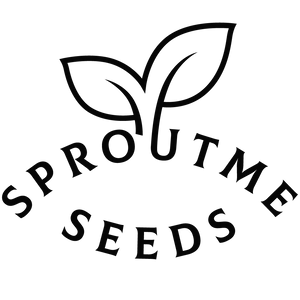Pepper Anaheim, also known as New Mexico chile or California green chile, is a versatile and flavorful pepper variety widely used in Mexican and Southwestern cuisine. Growing Anaheim peppers at home allows you to enjoy their mild heat and distinct flavor fresh from the garden, enhancing a variety of dishes with their unique taste.
Preparing for Growing:
- Selecting a planting location: Choose a sunny location with well-drained soil for optimal growth. Anaheim peppers thrive in warm climates with plenty of sunlight.
- Soil preparation: Prepare the soil by loosening it to a depth of 8-10 inches and incorporating organic matter, such as compost or aged manure, to improve soil fertility and drainage.
- Purchasing or preparing containers/pots: If growing in containers, choose pots with sufficient depth and drainage holes to accommodate the pepper plant's root system.
Starting from Seeds Indoors:
- Seed preparation: Soak Anaheim pepper seeds in warm water for 24 hours before planting to improve germination rates.
- Choosing suitable pots/containers: Use seedling trays or small pots filled with a seed-starting mix.
- Sowing and caring for seeds indoors: Sow Anaheim pepper seeds indoors 8-10 weeks before the last frost date in your area. Keep the soil consistently moist and provide bottom heat to encourage germination.
- Transplanting to larger containers if necessary: Once seedlings have developed several sets of true leaves, transplant them into larger containers or directly into the garden if outdoor conditions permit.
Starting from Seeds Outdoors:
- Soil preparation: Prepare the soil by removing weeds and debris and loosening it to a depth of 8-10 inches. Incorporate compost or organic matter to enrich the soil.
- Selecting appropriate timing and method for outdoor sowing: Directly sow Anaheim pepper seeds outdoors after the danger of frost has passed and the soil temperature has warmed to at least 60°F (16°C).
- Caring for seeds outdoors: Keep the soil consistently moist until seeds germinate, which typically occurs within 10-14 days.
Growing in Containers/Pots:
- Selecting suitable plants for containers: Anaheim peppers are well-suited for container gardening, especially in regions with limited space or cooler climates.
- Container and soil preparation: Choose containers with a minimum diameter of 12-18 inches and fill them with a well-draining potting mix enriched with compost.
- Sowing or transplanting plants into containers: Sow seeds or transplant seedlings into containers, spacing them 12-18 inches apart.
- Caring for container plants: Place containers in a sunny location and water regularly to keep the soil evenly moist. Provide support for pepper plants as they grow to prevent them from toppling over.
Transplanting to Garden:
- Soil and planting site preparation: Prepare the garden bed by incorporating compost and ensuring good drainage. Anaheim peppers prefer slightly acidic to neutral soil with a pH of 6.0-7.0.
- Correct timing and method for transplanting: Transplant seedlings outdoors after the danger of frost has passed and the soil has warmed. Space plants 18-24 inches apart in rows spaced 24-36 inches apart.
- Post-transplant care: Water transplanted seedlings thoroughly and provide shade if needed to prevent wilting.
Plant Care:
- Watering: Keep the soil consistently moist, especially during hot and dry periods. Avoid overhead watering to prevent foliar diseases.
- Fertilizing: Apply a balanced fertilizer or compost tea every 4-6 weeks to provide nutrients throughout the growing season.
- Weeding: Keep the garden bed or containers free from weeds to reduce competition for nutrients and moisture.
- Pest and disease management: Monitor plants regularly for signs of pests or diseases. Handpick pests like aphids and caterpillars, and treat fungal diseases with appropriate fungicides if necessary.
Harvesting:
- Determining when plants are ready for harvest: Anaheim peppers can be harvested green or left to ripen to a red color. Harvest peppers when they reach full size, typically 6-8 inches in length, by cutting them from the plant with pruners or scissors.
- Harvesting and storage guidelines: Store harvested peppers in the refrigerator for up to two weeks or freeze them for long-term storage. To freeze, wash and dry peppers, then remove stems and seeds before slicing or chopping for freezing.
When to Start from Seeds by USDA Plant Hardiness Zones:
- Start Anaheim pepper seeds indoors 8-10 weeks before the last frost date in your area for transplants, or sow seeds directly outdoors after the danger of frost has passed and the soil temperature has warmed to at least 60°F (16°C).
Fast Facts:
- Planting depth: Sow seeds 1/4 inch deep in the soil.
- Seed spacing: Plant seeds 1/2 inch apart in rows spaced 18-24 inches apart.
- Plant spacing: Transplant seedlings 18-24 inches apart in rows spaced 24-36 inches apart.
- Number of seeds per pot/container: Plant 1-2 seeds per pot or container.
- Water preferences: Keep soil consistently moist, but avoid overwatering to prevent root rot.
- Sun preferences: Anaheim peppers require full sun for optimal growth and fruit production.
- Soil type and other important factors: Well-draining soil rich in organic matter; pH 6.0-7.0.
- Companion Planting: Plant with basil, onions, or marigolds to deter pests and enhance growth.
- Temperature Preference: Thrives in warm temperatures; prefers daytime temperatures between 70-85°F (21-29°C).
- Days to Germination: 10-14 days.
- Days to Harvest: Approximately 65-75 days from transplanting.








